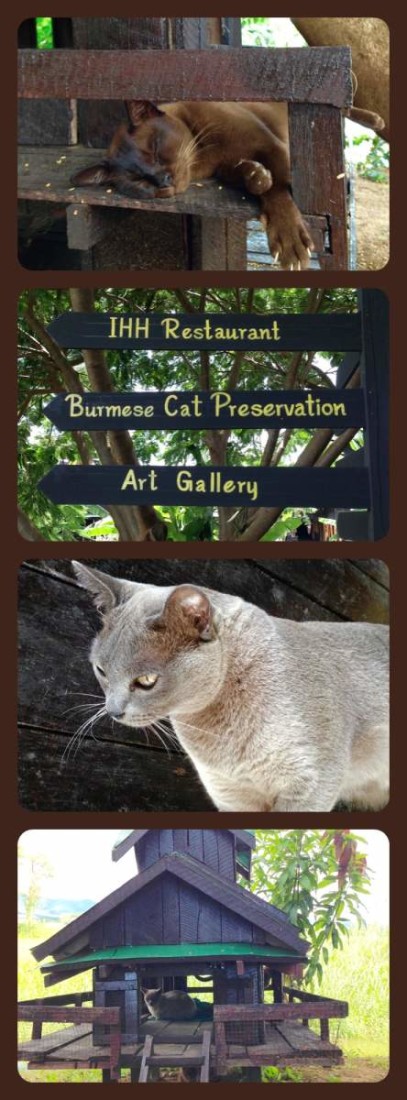Sometimes you assume something about the place you’re going to which turns out not to be true.
Travelling to Myanmar for the first time I thought that I would see lots of Burmese cats sunning themselves on windowsills or watching the world go by from their various clever cat vantage points.
After all, this is where they are from. It was here that they held the prestigious position of temple cats and were kept as pets by the Burmese royal family.
But it turns out while cat lovers around the world could easily identify a Burmese cat, most Burmese people today could not.
It is not until I am in the beautiful Inle Lake area that I discover that Burmese cats died out in their own country around the 1930s. Sadly after more than a thousand years of being revered they were left to breed with other cats that had been introduced to the country and then pure Burmese ceased to exist in Burma.
Thankfully before that happened some of that special Burmese bloodline had found its way to other countries. Which brings us to the sweet bit.
In 2009 seven Burmese cats from Australia and the UK were brought to their ancestral home of Myanmar to start a breeding program.
Today there are dozens of Burmese cats to be found in the breeding centres at Inle Lake, and cat lovers can pay a visit to their very own village and island.
Both the village and island are quite small, but they’re just fine for the cats and the whole being surrounded by water thing is just what these kitties need to prevent any great escapes or random tomcats paying a visit and ruining that bloodline.
Visitors can get their Burmese cuddles at the Inle Heritage House between 11am and 2pm. The set hours prevent the cats from being overwhelmed by all of the attention, which is for the best as we all know how good cats are at hiding their feelings when they’re not in the mood for something.
My visit was part of Trafalgar’s very first trip to Myanmar, a special media trip ahead of their first official guided holiday in January. We were lucky enough to be travelling with the woman who created the tour, Trafalgar’s Director of Asian Product Janice Farnum, and on the first day Janice and I met in Yangon we discovered we were both cat people and soon had our phones out over breakfast showing each other our cat photos (yes, sad but true).
When word got out that we’d be visiting a Burmese cat village at Inle Lake it was easy to tell the cat lovers from those who can’t quite see their charms.
Fortunately for those who just don’t get it, the Inle Heritage House is more than a crazy cat person place. It’s also a training ground for local people who want to work in hospitality, has a restaurant and cafe, and is where we all did a cooking class after picking vegetables and herbs from their gardens.
As we sat down to eat the delicious lunch we’d prepared (and yes it was delicious, though I credit the lovely girl who was helping us at our cooking station for saving my attempts at making local dishes) you could see some of us couldn’t wait to get down to the cats. Others clearly had more interest in lingering over dessert or perhaps having another glass of that refreshing Myanmar beer.
When Cat Time kicked in I was down those restaurant stairs lickety split and into the cat sanctuary below. As soon as I walked through the door into the large play area I had a couple of Burmese rubbing up against my ankles, and after being told it was okay to pick them up, soon had one climbing over my shoulders and purring loudly into my ears.
It was a beautiful thing, apart from the sharp pains in my shoulders thanks to the cat’s liberal use of its claws. After grinning through the pain for a little while I decided maybe it was best if we repositioned ourselves and so sat down on a lounge to allow the cat an easy dismount.
After playing with some of the cats in the spacious area in the main house, I went across the little bridge to their island where my fellow cat lovers were all being won over not only by the Burmese but also by their sweet little palaces. Some slept on tiny verandahs, others chilled out under trees, while the ones in the mood to play came up and gave us little head butts on the leg (and GoPro) or rubbed against us.
It was so strange to think that just a few years before none of this famous breed could have been found in the country, and I wondered how things may change in the years to come.
I loved Myanmar so much that I hope to visit again soon, but what about when I go back in ten or twenty years’ time? Will local people then know and love the cats that lived there a thousand years ago?
Time will tell on that one. For now I’m just grateful that this beautiful breed survived and that they’re once again living in their land.
Amanda Woods visited the Burmese Cat Village when she travelled as a guest of Trafalgar on their Myanmar tour as usual all opinions remain her own.
This post contains some affiliate links, so if you click on a link and book something I will get a little something to help pay those blogging bills, but don’t worry, it’s no extra cost to you. You can find out how and why I use travel affiliate programs here.
You can check out some travel tips and more in an interview with Global CEO of Trafalgar, Gavin Tollman.
Love your kitties? You may also want to check out what happened when I took my cat to stay at a five star hotel for a night, or get some tips on how to take a cat that hates cars on a road trip.











Leave a Comment